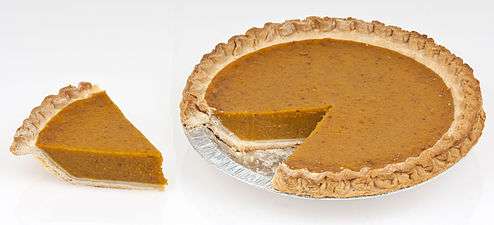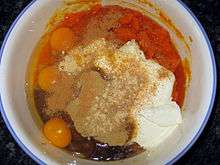Pumpkin pie
 | |
| Type | Pie |
|---|---|
| Course | Dessert |
| Place of origin |
United States Canada |
| Main ingredients | Pie shell, pumpkin, eggs, condensed milk, sugar, nutmeg, cinnamon, cloves, ginger |
|
| |
Pumpkin pie is a sweet dessert pie with a spiced, pumpkin-based custard filling. The pumpkin is a symbol of harvest time, and pumpkin pie is often eaten during the fall and early winter. In the United States and Canada, it is usually prepared for Thanksgiving and Christmas, and is also featured at Halloween.
The pie consists of a pumpkin-based custard, ranging in colour from orange to brown, baked in a single pie shell, rarely with a top crust. The pie is generally flavored with cinnamon, powdered ginger, nutmeg, and cloves. Allspice is also commonly used and can replace the clove and nutmeg, as its flavor is similar to both combined. Cardamom and vanilla are also sometimes used as batter spices. The spice mixture is called pumpkin pie spice.
The pie is often made from canned pumpkin or packaged pumpkin pie filling (spices included), mainly from varieties of Cucurbita moschata.
Preparation

Pies made from pumpkins use pie pumpkins; at about six to eight inches in diameter,[1] they are considerably smaller than jack o'lanterns. The pumpkin is sliced in half, and the seeds are removed. The two halves are heated until soft, in an oven, over an open fire, on a stove top, or in a microwave oven. Sometimes the pumpkin halves are brined to soften the pulp, rather than cooked. At this point the pulp is scooped out and puréed.
The pulp is mixed with eggs, evaporated and/or sweetened condensed milk, sugar, and a spice mixture called pumpkin pie spice, which includes nutmeg and other spices (e.g., ginger, cinnamon, cloves, allspice, mace), then baked in a pie shell.[1] Similar pies are made with butternut squash or sweet potato fillings.
History
The pumpkin is native to the continent of North America. The pumpkin was an early export to France; from there it was introduced to Tudor England, and the flesh of the "pompion" was quickly accepted as pie filler. During the seventeenth century, pumpkin pie recipes could be found in English cookbooks, such as Hannah Woolley's The Gentlewoman's Companion (1675).[2][3] Pumpkin "pies" made by early American colonists were more likely to be a savory soup made and served in a pumpkin[4] than a sweet custard in a crust.
It was not until the early nineteenth century that the recipes appeared in American cookbooks[2] or pumpkin pie became a common addition to the Thanksgiving dinner.[2] The Pilgrims brought the pumpkin pie back to New England,[5] while the English method of cooking the pumpkin took a different course. In the 19th century, the English pumpkin pie was prepared by stuffing the pumpkin with apples, spices, and sugar and then baking it whole.[6][7]
Today, throughout much of the United States, it is traditional to serve pumpkin pie after Thanksgiving dinner. Additionally, many modern companies produce seasonal pumpkin pie-flavored products such as candy, cheesecake, coffee, ice cream, french toast, waffles and pancakes, and many breweries produce a seasonal pumpkin ale or beer; these are generally not flavored with pumpkins, but rather pumpkin pie spices. Commercially made pumpkin pie mix is made from Cucurbita pepo, Cucurbita maxima, and Cucurbita moschata (Libbey Select uses the Select Dickinson Pumpkin variety of C. moschata for its canned pumpkins).[8][9][10]
In popular culture

Poetry
- Lydia Maria Child's Thanksgiving poem "Over the River and Through the Wood" (1844) references pumpkin pie in one of its verses: "Hurrah for the fun! Is the pudding done? / Hurrah for the pumpkin pie!"
- John Greenleaf Whittier wrote in his poem "The Pumpkin" (1850):[11]
Ah! on Thanksday, when from East and from West,
From North and from South comes the pilgrim and guest;
When the gray-haired New Englander sees round his board
The old broken links of affection restored;
When the care-wearied man seeks his mother once more,
And the worn matron smiles where the girl smiled before;
What moistens the lip and what brightens the eye,
What calls back the past, like the rich Pumpkin pie?

Songs
- Oscar Ferdinand Telgmann and George Frederick Cameron wrote the song "Farewell O Fragrant Pumpkin Pie" in the opera Leo, the Royal Cadet (1889):[12]
Farewell, O fragrant pumpkin pie!
Dyspeptic pork, adieu!
Though to the college halls I hie.
On field of battle though I die, my latest sob, my latest sigh
shall wafted be to you!
And thou, O doughnut rare and rich and fried divinely brown!
Thy form shall fill a noble niche in memory's chamber whilst I pitch
my tent beside the river which rolls on through Kingston town.
And my Love—my little Nell,
the apple of my eye to thee how can I say farewell?
I love thee more than I can tell;
I love thee more than anything—but—pie!
- The Christmas-themed song "There's No Place Like Home for the Holidays" makes a reference to homemade pumpkin pie being looked forward to by a man returning to his family's home in Pennsylvania.
- "Rockin' Around the Christmas Tree" contains the lyric, "Later we'll have some pumpkin pie / And we'll do some caroling".
- "Sleigh Ride", another popular Christmas song, also mentions sitting around a fire after being out in the snow and eating pumpkin pie.
Records
The world's largest pumpkin pie was made in New Bremen, Ohio, at the New Bremen Pumpkinfest.[13] It was created on September 25, 2010. The pie consisted of 1,212 pounds of canned pumpkin, 109 gallons of evaporated milk, 2,796 eggs, 7 pounds of salt, 14.5 pounds of cinnamon, and 525 pounds of sugar.[13] The final pie weighed 3,699 pounds (1,678 kg) and measured 20 feet (6 m) in diameter.[13]
See also
References
- 1 2 "How to Make Homemade Pumpkin Pie". PickYourOwn.org. Retrieved October 31, 2011.
- 1 2 3 Andrew F. Smith, "Pumpkins", The Oxford Encyclopedia of Food and Drink in America. Ed. Gordon Campbell. Oxford University Press, 2003. Saint Mary's College of California. 21 December 2011.
- ↑ Woolley, Hannah, The Gentlewoman's Companion … , 3rd ed. (London, England: Edward Thomas, 1682), "Pumpion pye", pp. 220–221.
- ↑ "American Classic IX: Pumpkin Pie". Good Eats.
- ↑ Colquhoun, Kate (2007-12-24). "A Dessert With a Past". New York Times. Retrieved 2010-12-04.
- ↑ Reports on the herbaceous plants and on the quadrupeds of Massachusetts, 1840
- ↑ "How did the squash get its name?". Library of Congress. Retrieved September 15, 2013.
- ↑ Richardson, R. W. "Squash and Pumpkin" (PDF). United States Department of Agriculture, Agricultural Research Service, National Plant Germplasm System. Retrieved November 23, 2014.
- ↑ Stephens, James M. "Pumpkin — Cucurbita spp.". University of Florida. Retrieved November 23, 2014.
- ↑ Baggett, J. R. "Attempts to Cross Cucurbita moschata (Duch.) Poir. 'Butternut' and C. pepo L. 'Delicata'". North Carolina State University. Retrieved November 23, 2014.
- ↑ "The Pumpkin- Poets.org - Poetry, Poems, Bios & More". Poets.org. Retrieved 2010-08-19.
- ↑ "Leo, the Royal cadet [microform] : Cameron, George Frederick, 1854-1885 : Free Download & Streaming : Internet Archive". Archive.org. 2001-03-10. Retrieved 2010-08-19.
- 1 2 3 "2010 World Record Pumpkin Pie". Pumpkin Nook. Retrieved 5 January 2011.
| Wikibooks Cookbook has a recipe/module on |
